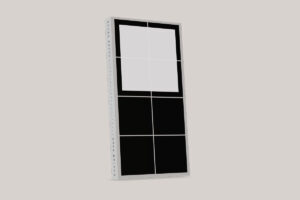YOUR CART
- No products in the cart.
Subtotal:
€ 0

Concept and photography:
Máté Bartha
Text contributions:
Emese Musci
Paul Dijstelberge
Design:
Carel Fransen
Lithography:
Gaëlle van den Dool (Wilco Art Books)
Production:
Jos Morree (Fine Books)
Print and binding:
Wilco Art Books (NL)
Supported by:
Embassy of the Kingdom of the Netherlands in Hungary
Anima Mundi, meaning ‘world spirit’, is rooted in Platonic thought and reflects the ancient concept of a universal organising principle that connects all beings. However, it’s not the existence of such a force, but humanity’s intrinsic need to believe in it that sparked the interest of Máté Bartha (HU).
Bartha explores the hidden anatomy of an archetypal metropolis, portraying urban space as a social product. A ‘second nature’ shaped by human hands, yet one that has evolved into an autonomous organism no longer governed by its creators. This challenges anthropocentric views and encourages a shift towards understanding the city through a post-human grammar.
Bartha takes on the role of a fictional observer, wandering through the metropolis like a detective in search of patterns, hidden connections, and the elusive ‘order of things’. Photographs of both real and staged scenes from various global locations are collaged into an unidentifiable, virtual cityscape. Grid structures, posters, and other urban elements recur as motifs, but offer no clear orientation, reflecting the ambiguity and complexity of modern life. Presented in a modular grid, they serve as metaphors for humanity’s attempt to find structure and meaning in an often arbitrary world.
Designed as an obscure encyclopedia, Anima Mundi draws inspiration from enigmatic works such as the Voynich Manuscript, Robert Fludd’s mystical diagrams, and Luigi Seraphini’s Codex Seraphinianus – each of which attempts to capture a world in its entirety through complex and often cryptic visual codes. Divided into chapters that examine urban phenomena from the microcosmic to the cosmic, it invites the reader to act as an interpreter, searching for a hidden logic behind the scenes.
Máté Bartha (1987) is a Hungarian photographer and documentary filmmaker. He holds a Master’s degree in Visual Communication from the Moholy-Nagy University of Art and Design and another in Documentary Filmmaking from the University of Theatre and Film Arts, Budapest. Bartha’s work explores the boundaries of documentarism, examining the interplay between reality and fiction. His photography series Kontact earned the Capa Grand Prize in 2018 and the Louis Roederer Discovery Award at the 2019 Rencontres d’Arles. Bartha’s documentary Downstream won multiple awards, including Best Student and First Film at the 2019 Verzio International Human Rights Film Festival. Bartha has exhibited his work internationally, with shows at the Polish FOTOFESTIWAL, RAY Photography Triennial in Germany, and Jimei × Arles. He is represented by TOBE Gallery in Budapest.